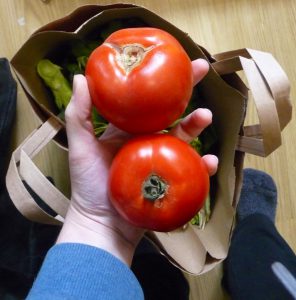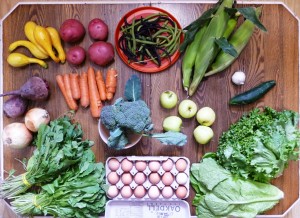 This is not a blog series about how to cook the food you get from the farm. You will not find regular recipes listed that are appropriate for the “exotic” and “unusual” ingredients you get from your local farmer. There are several reasons for this:
This is not a blog series about how to cook the food you get from the farm. You will not find regular recipes listed that are appropriate for the “exotic” and “unusual” ingredients you get from your local farmer. There are several reasons for this:
(1) The food that is local for me may not be local for you. I live in the Pacific Northwest, but the Internet is world-wide. I want this blog to be applicable emotionally, across the barriers of space and time. (She says, as she gets out of her DeLorean.)
(2) I am not a gourmet chef. Other people with better zeal for ingredients and food combos can let you know interesting dishes in the style of the Food Network or other complex cooking resources.
(3) I don’t think you need fancy recipes to eat local food. For the most part any summer veggie can be diced, salted, tossed with oil, and it’s ready to eat. Winter veggies may need to be diced or chopped; then they can be pan-fried, roasted or grilled; and finally seasoned with salt or other spices (to taste) and they are ready to eat.
Your farm is not exotic. It is not unusual. It is right around the corner. The sooner we stop thinking of cooking vegetables as this enormous and daunting task, the sooner we’ll all eat a lot more vegetables.
A few basic principles with vegetable preparation are:
– Add salt. Veggies are often bland. They need salt.
– Add a fat. Cook in lard or butter. Coconut oil is also good. Toss raw veggies in olive oil. The nutrients from the veggies will better be absorbed into your system in you eat them with fats. (Author Nina Planck is a big resource for this wisdom.)
– Use the internet; there are a lot of good recipe ideas out there if you get stumped, and you can always alter them to make them simpler. For instance, I found a fancy recipe that included roasted beets and a homemade honey mustard dressing. Before I found it, I never knew how to eat all the beets we got from the farm (and, boy, do we get a LOT!). Now, I know if I roast them and include honey or honey-mustard, they taste delicious.
– Go by the tips of your taste buds! Trust your gut, be bold, and if you screw up a dish, don’t fret. The more you prep veggies, the better you’ll become, and the more you’ll trust yourself.
Sometimes it’s nice to combine vegetables that are in season together, and sometimes it’s nice to just eat certain veggies by themselves. For instance, I like to chop up my white kohlrabi, boil it, and do the same to a couple potatoes, and then mash them up together for a mashed potato-kohlrabi side. It has a hint of a mashed cauliflower taste, in my opinion.
To illustrate how easy it is to prepare in season foods, I will share with you a recipe for my favorite salad: Shopska salad. Below is my take on this traditional Bulgarian salad. You can omit or add ingredients depending on what you have available, or what your tastes are. The core of the salad in the cucumbers, tomatoes, salt, and oil (I always have at least these four, but the proportions fluctuate depending on what’s in my kitchen and what taste I’m feeling like having more of); a simpler version of this recipe would be to say, “Chop tomatoes and cucumbers. Add salt and olive oil. Enjoy!”
SHOPKSA SALAD
Prepare the following ingredients, and put them in a medium bowl:
– 1 cucumber, chopped
– 2 medium tomatoes, diced OR 1-2 cups of cherry tomatoes, split in half
– ½ sweet pepper, chopped (I prefer orange or red peppers)
– 1 or 2 whole scallions (the green + white parts), diced
Salt liberally.
Add 1 cap of red wine vinegar (about 1 teaspoon).
Liberally pour extra virgin olive oil over the salad (I never measure, but I probably pour between ¼ and ½ cup, depending on the amount of veggies).
Toss!
You can dish it up right away, but if you let it sit on the counter for at least 30 minutes, with a dishcloth covering it, the oils will make a nice “sauce” for dipping fresh, sliced bread into. When serving, I always add crumbled or shredded feta on top of each salad bowl, at least an ounce per person. I don’t buy it pre-crumbled, I do that myself (it tastes better). The salty and creamy cheese really helps to round off this light and delicious summery treat!
Enjoy!
By ekwetzel
2010-09-10
 WEEK 10
WEEK 10
We received 2 tomatoes in the share, but I forgot to include tem in the “group picture,” so they are featured separately, above.
(Clockwise, from the eggs)
Eggs (again, the farm has young hens, and they are laying smaller eggs this week, so we received 18 eggs instead of the normal dozen)
Arugula
2 Onions
2 Beets
Summer Squash
4 Red Potatoes
Haricot (Green Beans and Purple Beans)
4 Ears of Corn
Head of Garlic
Cucumber
2 Heads of Lettuce
(In the middle, from the left)
Carrots
Broccoli
Apples

I love Rhubarb. If you have too much of it you can always share with me.